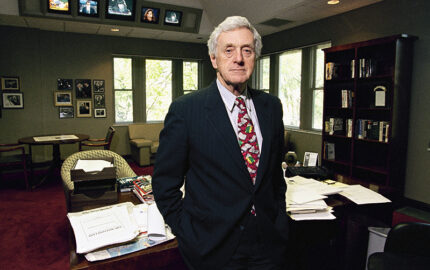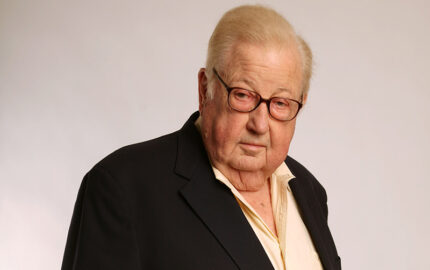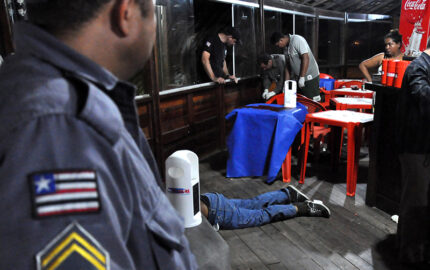
The Energy Beat: Complex and Compelling
To a journalist’s ear, the words “energy” and “crisis” belong together, in part because coverage of energy issues has been fueled largely by episodic coverage of difficulties people confront when sources of energy diminish—such as gasoline price hikes and shortages—or they vanish, as in electricity blackouts. To some degree this approach is changing as better-trained journalists pursue stories about energy and keep watchful eyes on a wider range of critical energy issues. – Melissa Ludtke, Editor
“This is the only profession I know of where you get on an airplane and fly first class, drinking champagne and eating caviar, only to arrive in some hellhole where you check into a third-rate hotel and see 50 of your best friends.” —Comment from an unidentified correspondent in the bar of the Hotel Alexandre, Beirut, summer 1982
I’ve seen my share of war zones and heard enough shots fired in anger to last a lifetime. The first war for me was India-Pakistan, in the 1971 battle for Bangladesh. Mercifully that conflict ended in just two weeks. Then Israel from 1974 to 1976, the infamous no-war, no-peace period, following the Yom Kippur War, but before the Camp David Accords. There I had to contend with terrorist attacks and Israeli reprisals. The conflicts were infrequent, but bloody.
After that, there was the Israeli invasion of Beirut in the summer of 1982, which was the most perfectly arranged of these wars, at least from the journalist’s standpoint. A vest-pocket sized battlefield, roughly half the size of Manhattan, Beirut provided more bang-bang per square mile than any war in recent memory. PLO fighters were dug in West Beirut and surrounded by Israelis and Lebanese forces in East Beirut. A journalist could interview combatants from both sides of the conflict and file by dinnertime. At night, to drown out the noise of the Israeli bombardment, I’d lie in bed with my headphones on, listening to Warren Zevon tapes. My favorites were “Lawyers, Guns and Money” and “Roland, the Headless Thompson Gunner.”
I knew I had to quit when I began to like the whole scene. I withdrew voluntarily from that most exclusive of news media clubs—the dogs of war.
Those experiences stayed with me, as did the battleground images that haunted my dreams. Then, after 20 years of teaching journalism at the University of California, I came to realize that being a journalist can damage one’s mental as well as physical health, even apart from the coverage of war. There is no doubt that day-to-day encounters with trauma and loss—the bread and butter of war journalism— take a heavy toll. But so does working the police beat in any major city. More people die in homicides or traffic accidents in the United States than die in Iraq on any given day. In fact, my first encounter with mangled bodies was when I covered an airplane crash in the San Fernando Valley.
In addition, the industry is changing. Technology now puts reporters under relentless pressure to be more productive. The idea of “convergence,” in which reporters often are expected to file for radio, television, Web sites, as well as print, has sped up the demand for news. Also the news industry is much more volatile and jobs are less secure than ever before. With constant pressures from deadlines and daily competition, stress has always been intrinsic to the practice of journalism. But in recent years it has grown so intense it has become a serious occupational hazard in covering the news, whether from the cop beat in Fresno, California, to the political beat in Annapolis, Maryland, to the Shiite neighborhoods of Baghdad.
Emotional Balance: The Journalism Course
Just as clergy can undergo a crisis of faith, I, too, found myself questioning what I was doing. As a journalism professor, I was training bright, attractive young people for jobs that were likely to leave them bitter, burned out, and unhappy after a few years. It was time for a change, and I drew inspiration from words sung by the blues singer Rice Miller, also known as Sonny Boy Williamson II:
“It took me a long time, to find out my mistakes
“Took me a long time, to find out my mistakes
“(it sho’ did man)
“But I bet you my bottom dollar, I’m not fattenin’ no more frogs for snakes”
My wife, Faith Fancher, a longtime broadcast reporter who worked for CNN, NPR, and then for KTVU-Channel 2 in the San Francisco Bay Area, developed breast cancer seven years ago. To help ease her discomfort from chemotherapy, I enrolled in a massage therapy course in July 2003. The 150-hour course was based on principles of Chinese Traditional Medicine (CTM). I earned a diploma as an acupressure massage practitioner and immediately enrolled in an additional 200 hours of CTM training.
Faith died in October 2003. The months of giving her massage did not save her life, but it made her more comfortable, and it gave me a strong sense of having done something helpful.
Out of that sad experience, I wondered whether the self-care strategies I learned as part of my CTM training might actually find a place in journalism education. Of course, it would be a radical departure from conventional notions of training reporters. I wrote a proposal to the faculty at Berkeley’s Graduate School of Journalism offering to teach a self-care course, titled “Emotional Balance for Working Journalists.” Here is the summation that went to my teaching colleagues:
“Acupressure is based on Chinese Traditional Medicine, a 2,000-year-old system of holistic healing with a rich literature and history. My meager 350 hours of training has only scratched the surface of CTM. But I gained enough experience to realize that massage, along with other kinds of bodywork, nutrition, meditation and related techniques derived from CTM, can make a difference in people’s lives.
“During my course work at the Acupressure Institute I discussed with the faculty the peculiar conditions under which journalists work. For example, they are the storytellers. When they tell stories of trauma, loss, suffering, they do not walk away clean. Yet, as an industry, the news media offer little if any preparation or comfort to its workers who face this kind of emotional meat grinder. Instead the journalists are expected to suck it up and move on. When somebody shoots up a schoolyard, the school officials routinely call in grief counselors to tend to the survivors. But the reporters and camera people who covered that story get no such attention. They saddle up and go off to the next crime scene.”
Some horselaughs were heard. One colleague believed that “emotional balance for journalists” is an oxymoron. “Journalists are prone to living highly vulnerable lives that are basically unbalanced—emotionally, spiritually, psychologically,” he said. But the faculty agreed to support this experimental course and, in January 2004, I began to teach it.

What’s Been Learned
The three-unit course for graduate students met for one hour three times a week from 8 a.m. to 9 a.m. On Monday and Wednesday, the class met in a seminar room, where we discussed readings and listened to occasional guest speakers. On Fridays, the class was held in the Hearst Gym, in a large exercise room with floor mats and mirrors like a yoga studio. During the 15-week semester, the class received demonstrations in bodywork, including massage, tai chi, chi gong, cranial-sacral therapy, and guided imagery. A dozen massage practitioners and other therapists from around the Bay Area volunteered their time to present the self-care techniques. The first session was a demonstration of Pilates exercise techniques. Little by little I introduced concepts from CTM.
As the course developed, the students were encouraged to share their experiences and reactions to what they were learning. Observations about themselves and their chosen career path were insightful. Here are postings from the class Web site:
- “In everyday life I see how friends talk too slow; people don’t get to the point fast enough (my brother exploded with a ‘stop being a damn journalist for a second and listen to my story …’).”
- “I think this is where the recommendation of dating/having friends who are not journalists comes in. (I don’t remember who made that point, but it was a good one.) Because, hopefully, they will call you on being too much of a journalist in your personal life and remind you that there are other things in life than grilling people.”
- “In the paper in Oregon, a lot of the reporters were the same age, late 20’s, early 30’s, and everyone hung out together. This helped in that you could talk about whatever story was stressing you out. But it contributed to a lot of alcohol entering my system. Those stereotypes about journalists being alcoholics, etc. are true, as far as I’ve seen.”
The 13 students in the class began to take a longer, more philosophical view of the work ahead of them. They accepted the idea that journalism can be corrosive, unless one takes protective measures. As part of the class, during the semester each student had to have one session of therapeutic massage and to participate in at least six sessions of some kind of energy exercise, such as yoga, Pilates or tai chi.
After the San Francisco Chronicle did a story about the class, I received words of support from throughout the world. One veteran network news correspondent sent me this message by email: “You’re way ahead of the pack suggesting ways to cope after the story. Trust me—crying and drinking too much are often not enough, although I’ve done my share of both. This is an amazingly unexplored area. Surprisingly, it has nothing to do with gender. I’ve seen women suffer as much as men.”
This correspondent sent me a videotape of a piece he did from a camp for Rwandan refugees at the height of the genocide. It showed one of the rare moments when a veteran journalist comes close to breaking down emotionally. This tape was immensely helpful in showing students that even those at the top of the profession have to struggle with their feelings.
As the semester drew to a close, I asked myself what had been learned. First, journalism education needs to make self-care a central part of its focus. I won’t teach this as a stand-alone course again, but I will incorporate these lessons and techniques into the school’s introductory writing and reporting course. Self-care is as important as learning to write a nut graf. Second, the industry itself needs to revise the prevailing “suck it up” approach. Newsrooms do not as a rule provide the same counseling and support services as the local sheriff’s department. Consequently, many reporters are afraid to admit to colleagues and supervisors that they are distressed because such an admission can be seen as a sign of weakness.
As journalism becomes more competitive we, as educators, have pushed students to do more, faster and leaner. How they live their lives outside the office and cope with what they see and do as part of their job has not been thought of as our concern. It’s time now to rethink this premise, but doing this will require change in the culture of newsrooms—a change that is long overdue. One Bay Area journalist wrote me a note about the course: “It’s so hard to strike that balance between doing good work and living healthy lives. But worth the effort.” I agree.
William J. Drummond is professor of journalism at the University of California at Berkeley. He’s a former editor and correspondent for National Public Radio and Los Angeles Times’s bureau chief in New Delhi and Jerusalem. He’s a certified acupressure massage practitioner.


